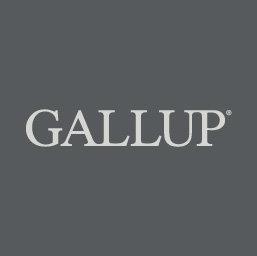
On Social Ideology, the Left Catches Up to the Right
Story Highlights
- 31% say they are socially liberal, 31% socially conservative
- This is the first time conservatives have not outnumbered liberals
- Conservatives maintain edge on economic issues
PRINCETON, N.J. -- Thirty-one percent of Americans describe their views on social issues as generally liberal, matching the percentage who identify as social conservatives for the first time in Gallup records dating back to 1999.

Gallup first asked Americans to describe their views on social issues in 1999, and has repeated the question at least annually since 2001. The broad trend has been toward a shrinking conservative advantage, although that was temporarily interrupted during the first two years of Barack Obama's presidency. Since then, the conservative advantage continued to diminish until it was wiped out this year.
The newfound parity on social ideology is a result of changes in the way both Democrats and Republicans describe their social views. The May 6-10 Gallup poll finds a new high of 53% of Democrats, including Democratic-leaning independents, describing their views on social issues as liberal.
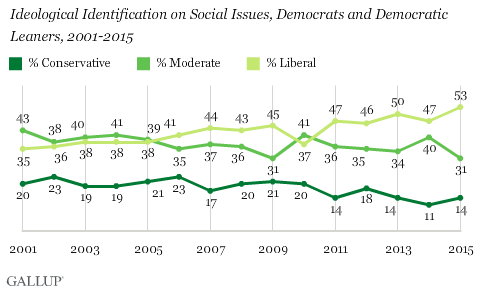
Democrats were more likely to describe their views on social issues as moderate rather than liberal from 2001 to 2005. Since then, socially liberal Democrats have outnumbered socially moderate Democrats in all but one year.
Meanwhile, the 53% of Republicans and Republican leaners saying their views on social issues are conservative is the lowest in Gallup's trend. The drop in Republicans' self-identified social conservatism has been accompanied by an increase in moderate identification, to 34%, while the percentage identifying as socially liberal has been static near 10%.
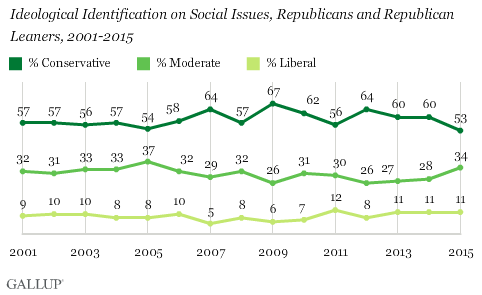
These trends echo the pattern in Gallup's overall ideology measure, which dates back to 1992 and shows increasing liberal identification in recent years. As with the social ideology measure, the longer-term shifts are mainly a result of increasing numbers of Democrats describing their views as liberal rather than moderate. That may reflect Democrats feeling more comfortable in describing themselves as liberal than they were in the past, as much as a more leftward shift in Democrats' attitudes on political, economic and social issues.
Conservatives Still Lead Liberals on Economic Issues
In contrast to the way Americans describe their views on social issues, they still by a wide margin, 39% to 19%, describe their views on economic issues as conservative rather than liberal. However, as on social ideology, the gap between conservatives and liberals has been shrinking and is lower today than at any point since 1999, with the 39% saying they are economically conservative the lowest to date.
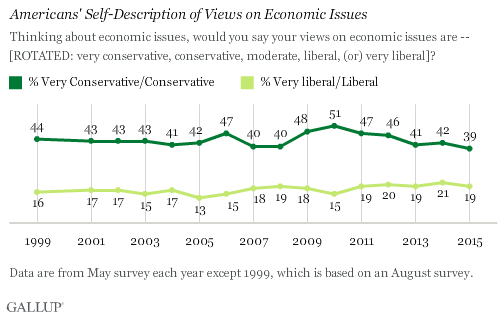
Currently, 64% of Republicans identify as conservative economically, which is down from 70% the previous two years and roughly 75% in the early years of the Obama presidency. During George W. Bush's administration, Republicans were less likely to say they were economic conservatives, with as few as 58% doing so in 2004 and 2005. The trends suggest Republicans' willingness to identify as economic conservatives, or economic moderates, is influenced by the party of the president in office, and perhaps the types of financial policies the presidential administration is pursuing at the time.
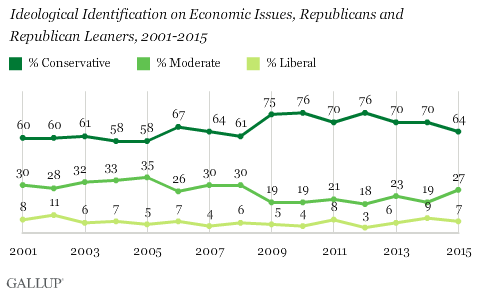
Democrats are also contributing to the trend in lower economic conservative identification. While the plurality of Democrats have consistently said they are economically moderate, Democrats have been more likely to identify as economic liberals than as economic conservatives since 2007. The last two years, there has been a 15-percentage-point gap in liberal versus conservative identification among Democrats on economic matters.
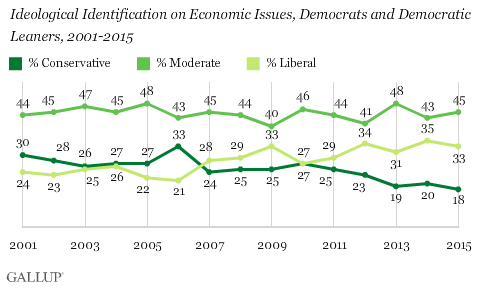
Implications
Americans' growing social liberalism is evident not only in how they describe their views on social issues but also in changes in specific attitudes, such as increased support for same-sex marriage and legalizing marijuana. These longer-term trends may be attributable to changing attitudes among Americans of all ages, but they also may be a result of population changes, with younger, more liberal Americans entering adulthood while older, more conservative adults pass on. Gallup found evidence that population replacement is a factor in explaining changes in overall ideology using an analysis of birth cohorts over time.
The 2016 presidential election will thus be contested in a more socially liberal electorate -- and a less economically conservative one -- than was true of prior elections. Economically and socially conservative candidates may still appeal to the Republican Party base in the primaries, but it may be more important now than in the past for the GOP nominee to be a bit less conservative on social issues in order to appeal to the broader general electorate.
And while Americans are less economically conservative than in the past, economic conservatives still outnumber economic liberals by about 2-to-1. As a result, Democrats must be careful not to nominate a candidate who is viewed as too liberal on economic matters if their party hopes to hold the White House beyond 2016.
Survey Methods
Results for this Gallup poll are based on telephone interviews conducted May 6-10, 2015, with a random sample of 1,024 adults, aged 18 and older, living in all 50 U.S. states and the District of Columbia. For results based on the total sample of national adults, the margin of sampling error is ±4 percentage points at the 95% confidence level. All reported margins of sampling error include computed design effects for weighting.
Each sample of national adults includes a minimum quota of 50% cellphone respondents and 50% landline respondents, with additional minimum quotas by time zone within region. Landline and cellular telephone numbers are selected using random-digit-dial methods.
View survey methodology, complete question responses, and trends.
Learn more about how Gallup Poll Social Series works.
